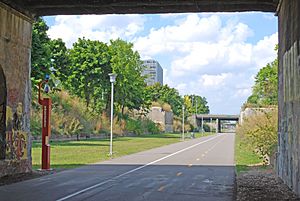Dequindre Cut facts for kids
The Dequindre Cut is a special pathway in Detroit, Michigan. It used to be a train track owned by the Grand Trunk Western Railroad. This pathway is below street level, like a trench. Most of it has been turned into a greenway, which is a green space for people to enjoy. You can still see lots of colorful graffiti art along the walls of the pathway.
What is the Dequindre Cut?
The Dequindre Cut is a pathway that runs from Mack Avenue south to Woodbridge Street. This area is between Jefferson Avenue and the Detroit River. It's a great place for walking and biking. The path is paved and has separate lanes for people on foot and people on bikes.
The pathway goes under many streets. It gets deeper as you go south. Eventually, it is about 25 feet (7.6 meters) below the street level. This deep section continues until it reaches the riverfront area. You can get onto the pathway using special ramps at Lafayette Street, Gratiot Avenue, and Wilkins Street. The cool graffiti art on the bridge supports was kept on purpose when the pathway was built.
History of the Pathway
The train line that became the Dequindre Cut was built a long time ago, in the 1830s. It was part of the Detroit and Pontiac Railroad. By the 1920s, Detroit had many factories. The train tracks and the way the city streets were laid out made traffic very slow.
In 1923, the city of Detroit and the railroad decided to fix this. They planned to build 22 "grade separations." This means they would make the train tracks go under the roads. This helped traffic move better. The Dequindre Cut was one of these projects. The tracks here connected to other lines and served big factories near the river.
By 1930, many of these underpasses were finished. This included the Chestnut Street Bridge. The nearby Antietam Avenue Bridge was also finished soon after. These bridges show how things were built back then.
Over time, fewer people used trains. Passenger trains stopped using this line in 1982. Freight trains stopped a few years later. Between 1998 and 2000, the railroad sold this section of track.
When the tracks were no longer used, the Dequindre Cut became a popular spot for graffiti artists. The concrete walls under the bridges protected their art from the weather. This hidden location was also perfect. Some amazing graffiti artworks were created here. Even after the pathway was turned into a greenway, new art has been added, like murals by the Hygienic Dress League Corporation.
In the late 1990s, there was an idea to use the Dequindre Cut for a freeway leading to new casinos. But the casinos were built somewhere else. So, the future of the Dequindre Cut was still open.
In 2003, a project called the GreenWays Initiative gave money to plan turning the Dequindre Cut into a greenway. More money came later, and construction started in 2005. The first part of the greenway, about 1.2 miles long, opened in 2009.
More construction began in 2013 to extend the greenway. This new section went from Mack Avenue to Gratiot. It also added an entrance to the Eastern Market. This extension was part of a bigger project called Link Detroit. It opened to the public in April 2016.
Images for kids





